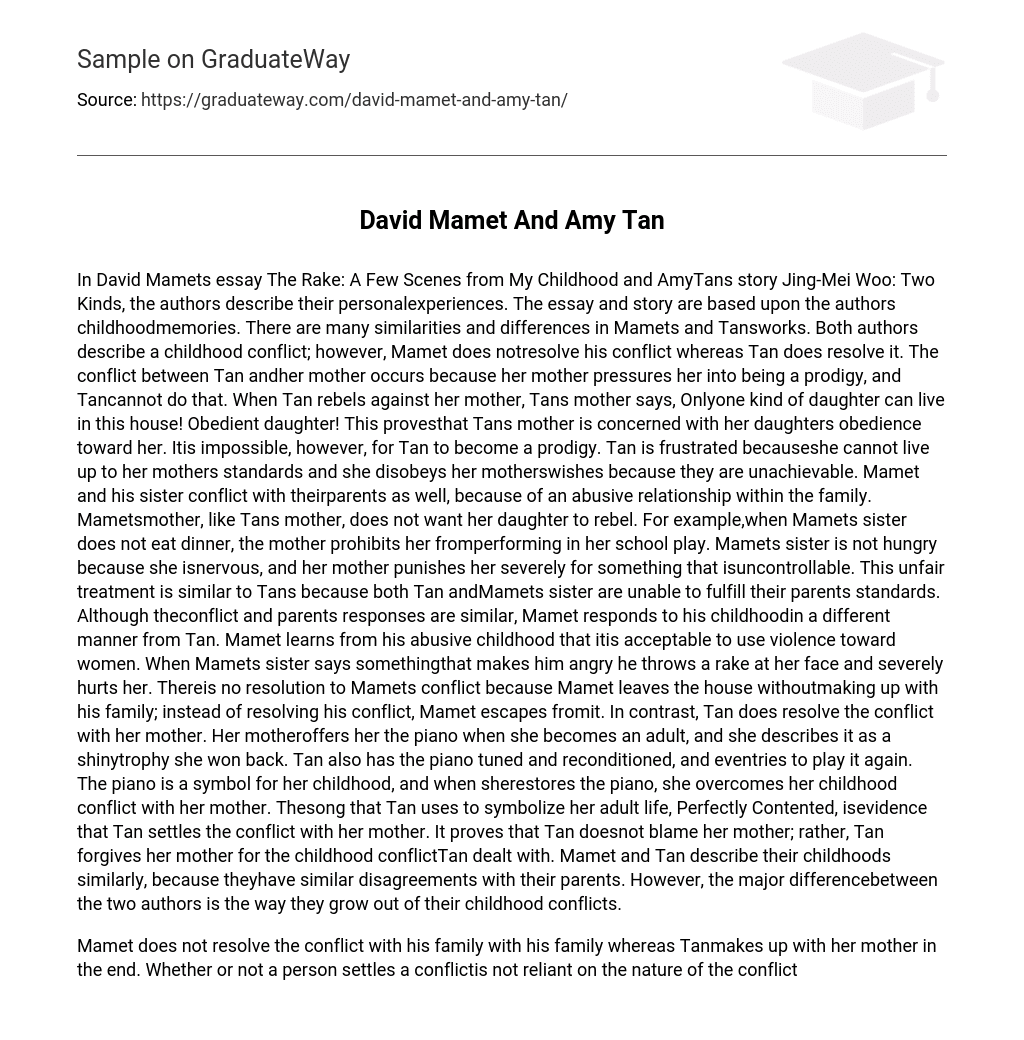In David Mamets essay The Rake: A Few Scenes from My Childhood and AmyTans story Jing-Mei Woo: Two Kinds, the authors describe their personalexperiences. The essay and story are based upon the authors childhoodmemories. There are many similarities and differences in Mamets and Tansworks. Both authors describe a childhood conflict; however, Mamet does notresolve his conflict whereas Tan does resolve it.
The conflict between Tan andher mother occurs because her mother pressures her into being a prodigy, and Tancannot do that. When Tan rebels against her mother, Tans mother says, Onlyone kind of daughter can live in this house! Obedient daughter! This provesthat Tans mother is concerned with her daughters obedience toward her. Itis impossible, however, for Tan to become a prodigy.
Tan is frustrated becauseshe cannot live up to her mothers standards and she disobeys her motherswishes because they are unachievable. Mamet and his sister conflict with theirparents as well, because of an abusive relationship within the family. Mametsmother, like Tans mother, does not want her daughter to rebel. For example,when Mamets sister does not eat dinner, the mother prohibits her fromperforming in her school play.
Mamets sister is not hungry because she isnervous, and her mother punishes her severely for something that isuncontrollable. This unfair treatment is similar to Tans because both Tan andMamets sister are unable to fulfill their parents standards. Although theconflict and parents responses are similar, Mamet responds to his childhoodin a different manner from Tan. Mamet learns from his abusive childhood that itis acceptable to use violence toward women.
When Mamets sister says somethingthat makes him angry he throws a rake at her face and severely hurts her. Thereis no resolution to Mamets conflict because Mamet leaves the house withoutmaking up with his family; instead of resolving his conflict, Mamet escapes fromit. In contrast, Tan does resolve the conflict with her mother. Her motheroffers her the piano when she becomes an adult, and she describes it as a shinytrophy she won back.
Tan also has the piano tuned and reconditioned, and eventries to play it again. The piano is a symbol for her childhood, and when sherestores the piano, she overcomes her childhood conflict with her mother. Thesong that Tan uses to symbolize her adult life, Perfectly Contented, isevidence that Tan settles the conflict with her mother.
It proves that Tan doesnot blame her mother; rather, Tan forgives her mother for the childhood conflictTan dealt with. Mamet and Tan describe their childhoods similarly, because theyhave similar disagreements with their parents. However, the major differencebetween the two authors is the way they grow out of their childhood conflicts.
Mamet does not resolve the conflict with his family with his family whereas Tanmakes up with her mother in the end. Whether or not a person settles a conflictis not reliant on the nature of the conflict itself. Resolution depends on thepersonalities and morals of the people involved.





